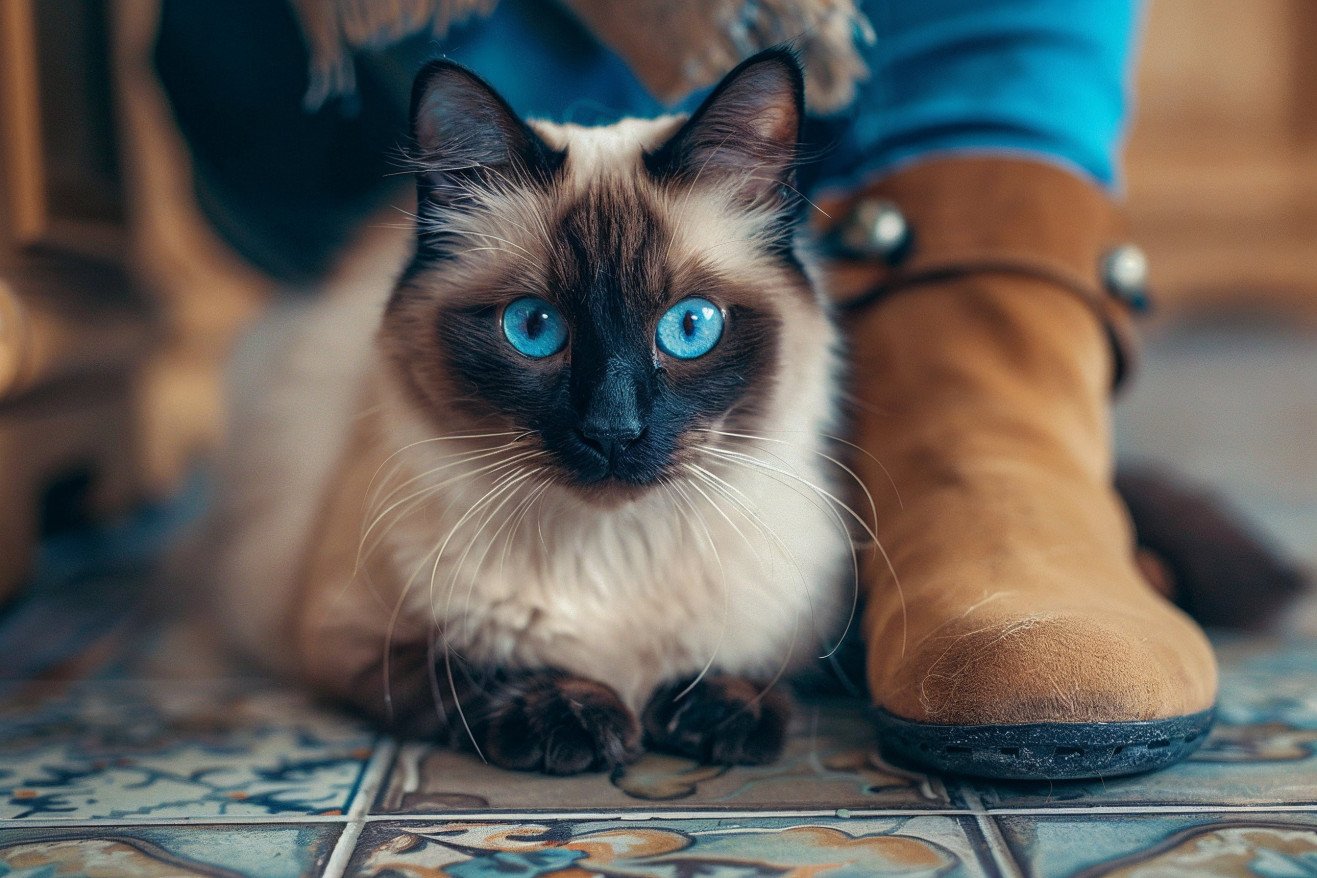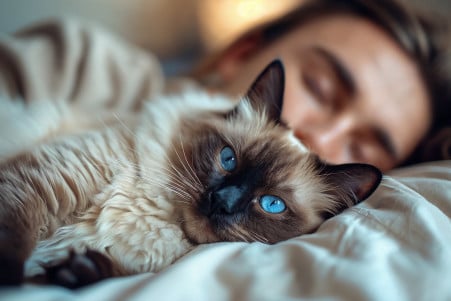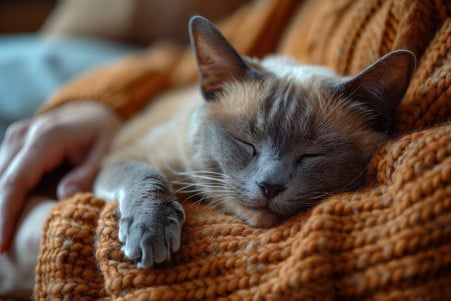Why Is My Cat So Clingy? Understanding Feline Attachment Behavior
19 March 2024 • Updated 18 March 2024

If your cat has gone from being loving to constantly underfoot, you’re not alone in asking this question. Cats can become clingy for a number of reasons, including changes in their living situation, stress, anxiety, and even medical conditions.
Some breeds and individual cats may also be more prone to clinginess. Making sure your cat has a stimulating environment and keeping a consistent schedule can help. Make sure to see a vet if your cat’s behavior changes suddenly.
To help you better understand why your cat is so clingy, we’ll look at information from veterinary medicine, animal behavior research, and cat psychology. We’ll also consider how the environment plays a role, the specifics of the human-animal relationship, and the potential genetic factors that may play a role in different breeds.
By the time you’re done reading, you’ll have a well-rounded view of the many reasons why a cat may be clingy and how you can address it.
Why is my cat so clingy?
The Genetic Makeup of Cat Attachment
The search for why your cat is so clingy may take us into the complicated world of genetics and breed genetics. A study that Psychology Today pointed out, conducted by Salonen et al. in 2019, found that certain traits, including human sociability, are moderately heritable. This means that up to 53% of the variation in these traits can be explained by genetics. So, a cat’s tendency to be clingy could be at least partially genetic.
A study that can be found on PMC and was done by Hannes Lohi suggests that breed genetics are also a factor. Different breeds have different personality traits that can make them more or less sociable and clingy. This is not a coincidence; it’s the result of the way breeders have bred cats over the years to emphasize certain traits in addition to physical ones.
While it’s clear that breeds can make some cats more or less likely to have certain traits, it’s important to note that breed is not destiny. Cats within a breed can have a wide range of personalities, and their environment is often just as important as their genetics in determining how they behave.
So while genetics may make some cats more likely to be clingy, their environment and how they were raised are just as important in determining their behavior.
Crafting the Purrfect Habitat: Environmental Impacts on Your Cat’s Attachment
A study published in PMC explains that a cat’s environment has a lot to do with how it behaves. Both the macroenvironment, which is the cat’s general living space, and the microenvironment, which is the space within a room or cage, affect how a cat will behave toward its owner and environment.
Changes in the home can cause stress and anxiety in cats, which can lead to increased clingy behavior as the cat seeks comfort and security.
The social environment is also important. According to WikiVet, a lack of social interaction with humans and other animals, or a sudden change in social interactions, can lead to attention-seeking behavior in cats. In addition, restricting a cat’s freedom without allowing it to express natural behaviors like scratching and climbing can lead to increased stress and dependence on the owner.
To prevent clingy behavior, the cat’s environment should be enriched and stimulating. This means the environment should include interactive toys, scratching posts, and different areas for the cat to explore, according to a study published in Animals. Not only will this help prevent stress-induced clingy behavior, but it will also improve the cat’s quality of life, leading to a happier, more well-adjusted pet.
Understanding the Neediness: When Clinginess Is a Sign of Something More
If your cat’s clingy behavior feels more like a cry for help than a request for attention, it’s time to dig deeper. VCA Animal Hospitals explains that cats are masters of disguise, and changes in behavior like increased clinginess could be a sign of an underlying health issue.
These changes in behavior could be the first signs of a medical problem. Metropolitan Veterinary Center explains that a cat’s change in behavior, whether it’s becoming more withdrawn or more clingy, can be a sign of pain or illness.
It’s important to look for changes in behavior. 7 Hills Veterinary Hospital says that a cat’s change in sociability, grooming, and eating and litterbox habits can all be signs that something is wrong. More serious signs that require immediate medical attention include frequent vomiting, rapid weight loss, or a cat not eating for more than 24 hours.
Before you chalk your cat’s clingy behavior up to their personality, it’s important to rule out medical issues. A thorough veterinary exam can help determine whether your cat’s behavior is a phase or a medical issue, and it can ensure that any medical issues are treated promptly and effectively.
Not only will recognizing and addressing these signs help your cat’s health, but it will also help strengthen your bond with your pet.
The Science of Purr-sistence: Attachment Theory and Needy Behavior
The psychological and emotional connections that you and your cat build are a result of a number of different factors and are incredibly complex. A review in PMC goes into detail about how cats show friendliness to humans, and how this impacts the level of attachment that humans feel toward their cats.
However, this friendliness is not a one-way street, and there is evidence that shows that human emotions can impact feline behavior as well.
One of the most important things that attachment theory has shown is that cats experience the Secure Base Effect (SBE), which was found in about half of the cats studied in a paper in Applied Animal Behaviour Science.
This means that cats use their humans as a secure base from which to explore and a safe haven to return to when they are stressed, which shows how important humans are in helping cats feel secure.
In addition, cats also use direct communication, like the slow blink, to show their humans that they are friendly and to open up the lines of communication between them.
When both cats and humans use these non-verbal cues to communicate, it can help cats feel more secure, and it can also help humans feel better.
As a result, it’s important to understand these non-verbal cues and how they can impact both you and your cat in order to help you deal with clinginess and make sure that you have a healthy relationship in which both you and your cat feel safe and understood.
Early Experiences: The Lasting Impact of Kittenhood on Personality
The groundwork for a cat’s personality is laid in kittenhood, and this is especially true of their social personality. The most important time for socialization is between 2 and 7 weeks of age, and the lessons learned during this time will continue to influence the cat throughout its life, according to The Anti-Cruelty Society. Positive experiences during this time will help ensure that the cat grows up to be confident and comfortable around people.
Meanwhile, a 2021 study by Smith et al. in Animals found that both hormonal and socio-environmental factors, including testosterone and the timing of human contact, play a role in the development of human-directed behavior in male cats. Exposure to a wide range of people early in life can help ensure that a kitten will be comfortable around people, which may help prevent clingy behavior in the future.
CatTime notes that it’s important to continue to expose kittens to a wide range of experiences after the socialization period in order to maintain their ability to adapt. As a result, in order to have a cat that’s less likely to develop attachment issues, including clingy behavior, it’s important for cat parents to continue to expose their kittens to a wide range of experiences and people and to keep this up as they mature.
Wrapping Up: Deciphering Feline Attachment Behavior
By learning more about why cats may become clingy, we have delved into the complexities of genetics, the impact of the environment, the importance of health issues, and the power of the human-cat relationship. It is clear that clinginess is a complex issue that is influenced by a cat’s genetic predisposition, environmental factors, medical issues, and the strength of the bond between a cat and their human.
As we have discussed, it is important to understand the factors that may lead a cat to become clingy in order to ensure their well-being. This is a combination of nature and nurture, with genetic predispositions interacting with the environment of a loving home or a stressful living situation.
We hope that cat owners will be aware, proactive, and responsive to their cats’ behaviors. When a cat’s behavior changes, it is important to seek out professional help. By understanding and addressing the factors that may lead to a cat becoming clingy, we can strengthen our bond and improve our lives together. In summary, let’s celebrate our cats’ unique personalities while always making sure to meet their behavioral needs with respect and love.


